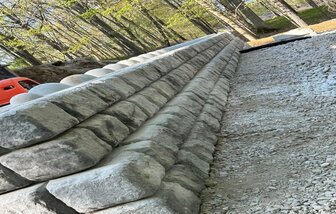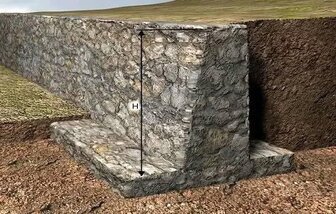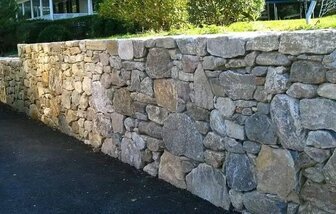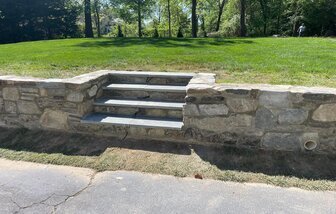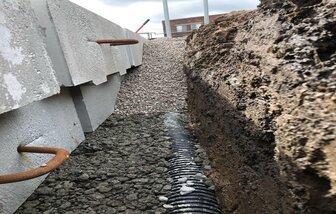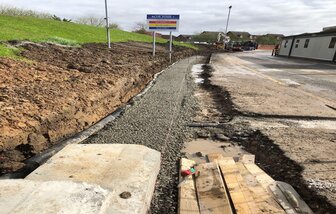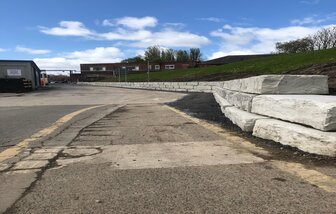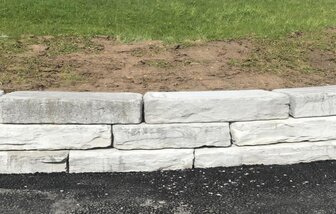What Building Materials Are Used to Build a Retaining Wall
Learn about different types of retaining walls and their applications, including concrete blocks, poured concrete, natural stone, brick, timber, and gabion baskets. Understand their benefits, limitations, and how to choose the right material for your project to ensure both functionality and aesthetic appeal.
Introduction to Retaining Walls Construction Materials
Retaining walls are essential structures designed to hold back soil and prevent erosion, thus maintaining the landscape’s integrity. They play a crucial role in managing water runoff, which can otherwise lead to significant erosion and destabilisation of the terrain.
By creating level areas, retaining walls also enable the utilization of land in hilly or uneven regions, transforming previously unusable spaces into functional areas for construction, gardening, or recreation.
The importance of retaining walls extends beyond just soil stabilisation. They also contribute to the aesthetic appeal and structural stability of a site.
These walls can be found in various settings, from residential backyards to large commercial projects, each serving the dual purpose of functionality and form.
There are several types of retaining walls, each designed to address specific needs and conditions. Gravity walls, for instance, rely on their mass to resist the pressure from the soil behind them.
They are typically constructed from heavy materials like concrete, stone, or brick. Cantilevered walls, on the other hand, use a different approach by utilising a stem and base slab that work together to hold back the earth. These walls are often reinforced with steel to provide additional strength.
Lastly, anchored walls are employed in situations where additional support is needed. These walls use anchors, which are driven into the ground behind the wall and then attached using cables or other means to provide extra stability. This type of retaining wall is particularly effective in areas with loose or unstable soil.
Understanding the various types of retaining walls and their applications is fundamental to selecting the appropriate structure for a given project.
Each type offers unique benefits and is suited to different environmental conditions, ensuring both the safety and utility of the space. The careful design and construction of retaining walls are thus paramount in landscape engineering and management.
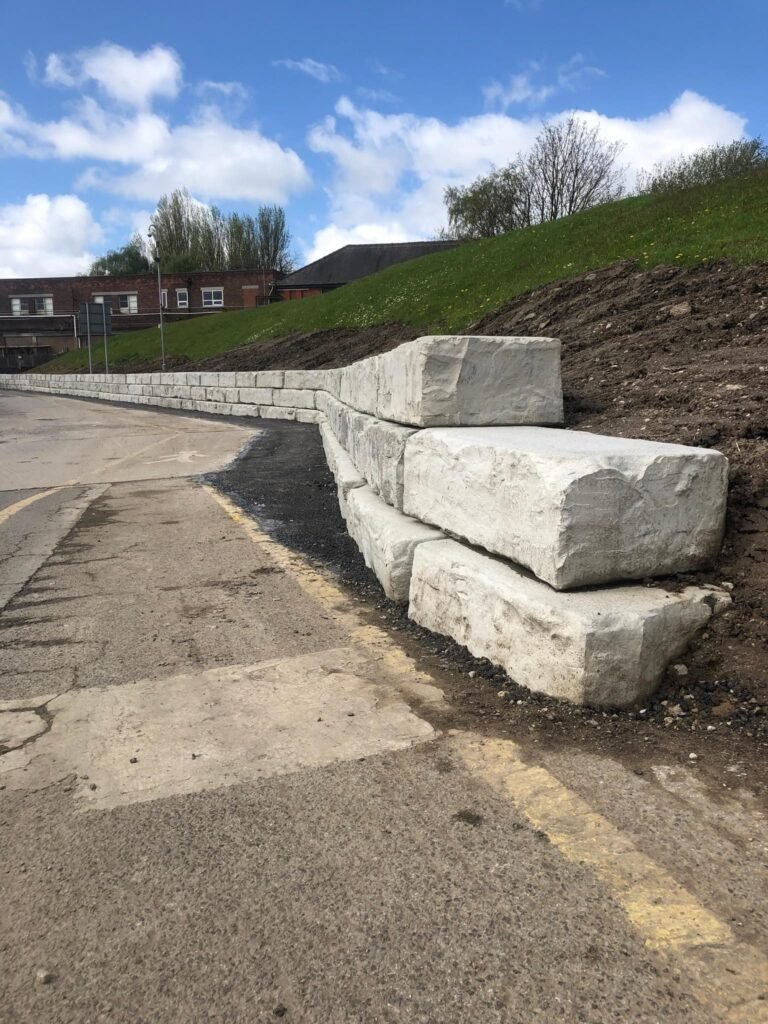
Concrete blocks are a prevalent choice in the construction of retaining walls due to their versatility and reliability. There are various types of concrete blocks used in retaining wall structures, each offering distinct advantages and applications. Among these, segmental retaining wall blocks and interlocking blocks are particularly popular.
Segmental retaining wall blocks are engineered to create flexible, enduring retaining walls. These blocks are designed to interlock with each other, allowing for the construction of walls that can withstand significant lateral forces without the need for mortar. This interlocking feature not only simplifies the installation process but also enhances the wall’s stability. The durability of segmental retaining wall blocks makes them suitable for both residential and commercial projects, providing long-term structural integrity.
Interlocking concrete blocks, on the other hand, offer unique design flexibility. These blocks can be arranged in various patterns and configurations, catering to both functional and aesthetic requirements. The interlocking mechanism ensures that the blocks stay firmly in place, even under adverse conditions. This type of block is particularly advantageous for constructing walls with curves or intricate designs, as the interlocking system allows for greater adaptability on site.
One of the primary benefits of using concrete blocks in retaining wall construction is their durability. Concrete is a robust material that can endure harsh weather conditions and heavy loads. Additionally, concrete blocks come in a variety of shapes, sizes, and colors, providing numerous aesthetic options to complement the surrounding landscape. The ease of installation is another significant advantage, as many concrete block systems require minimal tools and labor, reducing overall construction time and costs.
However, there are some limitations to consider when using concrete blocks for retaining walls. A strong foundation is essential to support the structure, as any weakness in the base can compromise the wall’s stability. Furthermore, concrete blocks, like all concrete products, are susceptible to cracking over time due to natural settling or external pressures. Proper installation and regular maintenance are crucial to mitigate these potential issues.
Poured concrete is a popular choice for constructing retaining walls due to its exceptional strength and versatility. The process involves pouring a concrete mixture into a pre-built mold, allowing it to take on various shapes and sizes to fit the specific needs of a project. This adaptability makes poured concrete ideal for both residential and commercial applications where unique design and structural integrity are paramount.
One of the primary advantages of using poured concrete for retaining walls is its robust nature. When properly mixed and cured, concrete can withstand substantial pressure and environmental wear, ensuring long-lasting durability. It is particularly effective in supporting large loads and managing soil erosion, which are common challenges in retaining wall construction.
To maximize the benefits of poured concrete, proper drainage and reinforcement are crucial. Adequate drainage systems must be integrated to prevent water buildup behind the wall, which can lead to hydrostatic pressure and potential failure. Additionally, reinforcing the concrete with steel bars (rebar) helps prevent cracking and enhances the wall’s overall strength. These reinforcements are essential to maintain the structural integrity of the wall over time.
While the benefits of poured concrete are clear, there are also considerations to keep in mind. The cost of materials and labor can be higher than other retaining wall options, as the process often requires professional installation. Skilled workers are essential to ensure the correct mixture, pouring, and curing techniques are employed, which adds to the overall expense.
In conclusion, poured concrete offers a reliable and versatile solution for retaining walls, providing strength and the flexibility to accommodate various designs. Proper drainage and reinforcement are key to its success, and while it may involve higher costs and professional installation, the resulting durability and performance make it a valuable investment.
Natural stone is a favored material for building retaining walls due to its timeless aesthetic appeal and robust durability. Among the various types of natural stones commonly employed, granite, limestone, and sandstone stand out. Each of these stones offers unique characteristics that make them suitable for different design and functional needs. Granite, known for its strength and resistance to weathering, is an excellent choice for retaining walls that require long-term durability. Limestone, with its softer texture, provides a classic appearance and is relatively easier to work with, making it popular for more intricate designs. Sandstone, with its warm hues and natural layering, adds a rustic charm to landscaping projects.
One of the primary advantages of using natural stone in retaining walls is its ability to blend seamlessly with the surrounding environment. The natural look of stone enhances the overall landscape, creating a harmonious and visually appealing outdoor space. Additionally, natural stone retaining walls can be constructed in various styles, from dry-stacked to mortared, allowing for flexibility in design and function.
However, there are challenges associated with using natural stone for retaining walls. The higher cost of these materials is a significant consideration, as natural stone tends to be more expensive than other building materials. Furthermore, constructing a natural stone retaining wall requires skilled labor to ensure proper placement and stability, which can add to the overall expense. The potential for uneven settling is another challenge, as natural stone can shift over time if not properly installed and supported. This necessitates thorough site preparation and ongoing maintenance to preserve the integrity of the wall.
In conclusion, while natural stone offers numerous benefits in terms of aesthetics and durability, it also presents certain challenges. Weighing the pros and cons carefully will help in making an informed decision about using natural stone for retaining wall construction.
Bricks are a popular choice in the construction of retaining walls, offering both aesthetic and functional benefits. One of the primary advantages of using bricks is their classic appearance, which can complement a wide range of architectural styles. Bricks come in an array of colors and styles, allowing for customization to match the specific design preferences of a project. This versatility makes brick retaining walls a favored option for both residential and commercial properties looking to enhance their visual appeal.
In addition to their aesthetic benefits, brick retaining walls are known for their strength and durability. Bricks are a robust material that can withstand significant pressure and environmental stressors. When properly constructed, brick retaining walls can last for decades, providing a long-term solution for preventing soil erosion and managing landscape elevation changes. However, it is crucial to ensure that a solid foundation is laid before the construction of the wall to prevent future structural issues.
Another important consideration in the construction of brick retaining walls is the implementation of effective drainage systems. Without proper drainage, water can accumulate behind the wall, leading to potential water damage and compromising the integrity of the structure. Installing weep holes or a drainage pipe system can help mitigate this risk, ensuring that water is efficiently directed away from the wall.
It is worth noting that brick retaining walls can be more costly compared to other materials. The expense is not only due to the cost of the bricks themselves but also because of the labor-intensive process of laying each brick precisely. Despite the higher initial investment, many property owners find that the longevity and aesthetic benefits of brick retaining walls justify the cost.
Timber is a popular choice for constructing retaining walls, particularly for those seeking a natural, aesthetic appeal that seamlessly integrates with outdoor environments. The organic texture and warm tones of timber provide a visually pleasing contrast to both greenery and stone, making it a favored option for landscaping projects. Among the types of wood commonly utilized, treated pine and cedar stand out due to their inherent properties and availability.
Treated pine is frequently selected for its affordability and versatility. The treatment process imbues the wood with preservatives that enhance its resistance to decay and insect infestations, extending its functional lifespan. Cedar, on the other hand, is prized for its natural resistance to rot and pests, as well as its attractive appearance. Although more costly than treated pine, cedar offers a longer-lasting solution without the need for chemical treatments.
One of the primary benefits of using timber for retaining walls is the ease of installation. Timber is relatively lightweight compared to other materials, which simplifies the handling and construction processes. This can result in reduced labor costs and quicker project completion times. Additionally, timber walls can be built using basic tools and techniques, making them accessible for DIY enthusiasts. The cost-effectiveness of timber, especially treated pine, is another significant advantage, providing a budget-friendly option without sacrificing aesthetic appeal.
However, timber retaining walls do come with certain limitations. Despite treatment, timber is inherently susceptible to rot, particularly when exposed to constant moisture. Termite damage is another risk, especially in regions where these pests are prevalent. Furthermore, timber retaining walls generally have a shorter lifespan compared to alternatives like concrete or stone. Regular maintenance, such as reapplying sealants and inspecting for pest damage, is necessary to prolong the life of a timber wall. Ultimately, while timber offers numerous benefits, it is essential to weigh these against its potential drawbacks to determine its suitability for a specific project.
Gabion baskets are a popular choice in retaining wall construction, known for their versatility and sustainability. Essentially, gabion baskets are wire mesh containers that are filled with a variety of materials, such as rocks, recycled concrete, or other aggregate substances. These baskets are then stacked and connected to form a sturdy, functional retaining wall. The materials used to fill the baskets can vary based on availability and desired aesthetic, allowing for customization and environmental considerations.
One of the primary benefits of gabion baskets is their flexibility. Unlike rigid retaining wall systems, gabion walls can adapt to changes in the landscape, such as soil movement and water flow, without compromising their integrity. This adaptability is crucial in areas prone to erosion or shifting ground. Additionally, gabion baskets are permeable, which allows water to pass through the wall, reducing hydrostatic pressure and the risk of wall failure.
Gabion baskets are also favored for their ease of installation. They can be assembled on-site and filled with local materials, which can reduce transportation costs and the project’s overall environmental footprint. Moreover, the construction process does not require specialized equipment or highly skilled labor, making it accessible for various projects.
The aesthetic appeal of gabion baskets is another significant advantage. The natural look of the rocks or recycled materials can blend seamlessly with the surrounding environment, creating a visually pleasing structure. Additionally, gabion walls can incorporate vegetation, enhancing their appearance and contributing to local biodiversity. Plants can grow between the gaps in the baskets, creating a living wall that changes with the seasons.
However, gabion baskets do have some potential drawbacks. One consideration is the need for regular maintenance. Over time, the wire mesh can corrode or become damaged, necessitating repairs or replacement. Additionally, the industrial look of the wire mesh may not be suitable for all settings, particularly in areas where a more polished or traditional appearance is desired.
When deciding on the appropriate material for building a retaining wall, it’s crucial to weigh several factors, including cost, durability, aesthetics, and the specific requirements of your project site. Each material, whether it be concrete, stone, brick, wood, or gabion, comes with its own set of advantages and disadvantages that should be carefully considered.
Concrete is often favored for its strength and longevity. It can withstand heavy loads and adverse weather conditions, making it highly durable. However, it can be more expensive upfront compared to other materials, and its appearance may not appeal to everyone.
Natural stone offers a timeless and aesthetically pleasing look. It blends seamlessly with the natural environment and provides excellent durability. On the downside, stone can be quite costly and labor-intensive to install, particularly if a custom design is required.
Brick is another durable option that provides a classic appearance suitable for many architectural styles. Bricks are relatively easy to work with and offer good resistance to weathering. However, they can be more expensive than wood and may not suit all design preferences.
Wood is often chosen for its affordability and ease of installation. It can be treated to improve its resistance to rot and insects. Nonetheless, wood may not be the most durable option over the long term, especially in wet or termite-prone areas.
Gabions, which are wire cages filled with stones or other materials, provide a robust and flexible retaining solution. They are particularly effective in areas prone to erosion and can be more cost-effective. However, their industrial look might not suit every project.
To make an informed decision, consider the specific needs of your site. Assess the soil type, drainage requirements, and the wall’s intended height and load. Budget constraints and aesthetic preferences will also play a significant role in your choice.
No matter the material selected, ensure the retaining wall is constructed with proper engineering standards. This includes adequate drainage, a stable foundation, and appropriate reinforcement where necessary. By carefully evaluating your options and adhering to best practices, you can build a retaining wall that is both functional and visually appealing.
What is a Retaining Wall?
Discover the essential aspects of retaining walls in landscape architecture. This comprehensive guide covers the types of retaining walls, materials used, and key design considerations. Learn about the construction process, regulations, and maintenance tips to ensure stability and longevity.
Types of Retaining Walls
Discover the importance of retaining walls in the UK, used to stabilise sloped terrain, prevent soil erosion, and manage water runoff. Learn about different types including gravity, cantilever, sheet piling, anchored, gabion, and reinforced soil retaining walls, and understand their applications, materials, advantages.
What is the purpose of Retaining Walls?
Discover the importance of retaining walls in landscaping and structural engineering. Learn about different types of retaining walls such as gravity walls, cantilever walls, sheet piling walls, and anchored walls.
Garden Retaining wall
Discover the essential role garden retaining walls play in landscaping, from erosion control to aesthetic enhancement. Learn about the benefits, popular materials, and design ideas to transform sloped gardens into functional and beautiful outdoor spaces.
Building Retaining Walls
Learn about retaining walls and their essential role in landscape design, offering both functional and aesthetic benefits. Discover various types of retaining walls, suitable materials, and important planning and design considerations to ensure stability and sustainability.
Foundation Depths For Retaining Walls
Discover the importance of retaining walls in landscaping and structural engineering. Learn about different types of retaining walls such as gravity walls, cantilever walls, sheet piling walls, and anchored walls. Follow a step-by-step guide
How to maintain Retaining Walls
Learn all about retaining walls, their importance in preventing soil erosion, and their applications in both residential and commercial settings in the UK. Discover the different types of retaining walls, how to inspect and maintain them, and the best practices
Retaining Wall Building Materials
Learn about different types of retaining walls and their applications, including concrete blocks, poured concrete, natural stone, brick, timber, and gabion baskets. Understand their benefits, limitations, and how to choose the right material for your project to ensure both functionality and aesthetic appeal.
Ready to start your project?
Let's Work Together
To get started, for general enquiries simply complete the form below. Provide us with your project details, and our team will review your requirements. We will then get back to you with a customised solution that fits your needs. Whether you have a small-scale project or a large-scale development, we have the expertise and resources to handle it.
If you prefer, you can also send us your project documents and any photographs to Price@totalregen.co.uk for pricing. We will carefully review your documents and provide you with a competitive quote.

